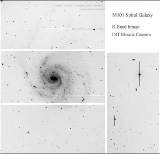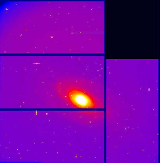 | |||
|
| Home > Astronomy > Detectors > WFC |
|
Warning : these figures refer to WFC when it was used with a Dutch controller and are for reference only. WFC Parameters
Device Identification
|
|
|
|
|
|
|
|
|
|
|
|
|
|
|
|
|
|
|
|
|
|
|
|
|
|
|
|
|
|
|
|
|
|
|
|
|
|
|
|
|
|
|
|
|
|
|
|
|
|
|
|
|
|
|
|
|
|
|
|
|
|
|
|
|
|
|
|
|
|
|
|
|
|
|
|
|
|
|
|
|
|
|
|
|
|
|
|
|
|
Physical Characteristics
Pixel Scale 0.333 arcsec/pixel
Field of view 34 x 34 arcmin
Pixel Size 13.5 microns x 13.5 microns
X size of digitised area in pixels (each ccd) 2148
Y size of digitised area in pixels (each ccd) 4128
X size of useful imaging area ( each ccd ) 2048
Y size of useful imaging area ( each ccd ) 4100
X start of useful imaging area ( each ccd ) 50
Y start of useful imaging area ( each ccd ) 0
LN2 capacity of cryostat 6 litres
Cryostat window thickness and distance of chips from window.
Details of gaps between image areas of mosaic elements.
Operational Parameters
Operating temperature -153K
Prefered amplifier - all CCDs have 2 working amplifiers, however, CCD1 shows very poor HCTE when using right hand amp. so all 4 EEVs are read out using the left hand amp. (28/4/98)
Anti-blooming - this is available and removes or reduces the effects of saturated stars blooming up and down a column, it can only be en/disabled by the duty engineer. ( block 18 of ram-disk )
Measured Characteristics
Quantum Efficiency ( @-120C )
|
|
|
|
|
|
|
|
|
|
|
|
|
|
|
|
|
|
|
|
|
|
|
|
|
|
|
|
|
|
Full QE curve for EEV4280
measured at ATC March 99 ![]()
Dark Current
Measured in electrons per pixel per hour
|
|
|
|
|
|
|
|
|
|
|
|
|
|
|
|
|
|
Full Well Bloom Limit 200000e
Chip flatness and Co-planarity
Individual EEV CCDs have a convex bow of between 6 and 10 microns. The mosaic co-planarity is within +/-20um. It is recommended that when focusing the camera, stellar images should be optimally focused at the three points :
- CCD1 : column = 1400, row = 500
CCD2 : column = 2000, row = 100
CCD3 : column = 1500, row = 370
(co-ordinates assume use of left hand amplifiers)
Pretty Pictures
| Top | Back |
|





